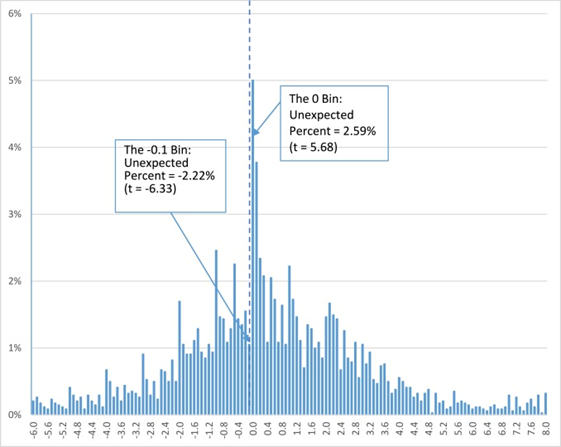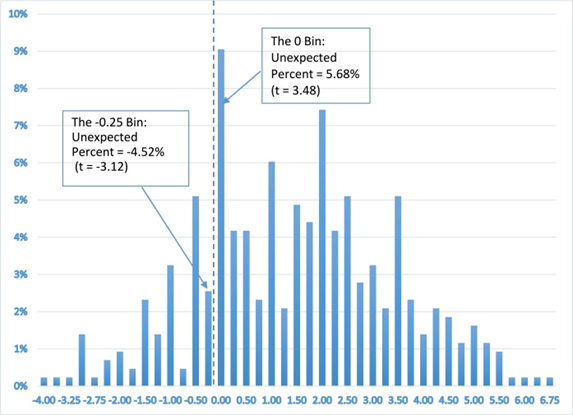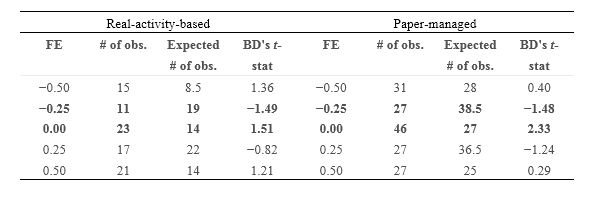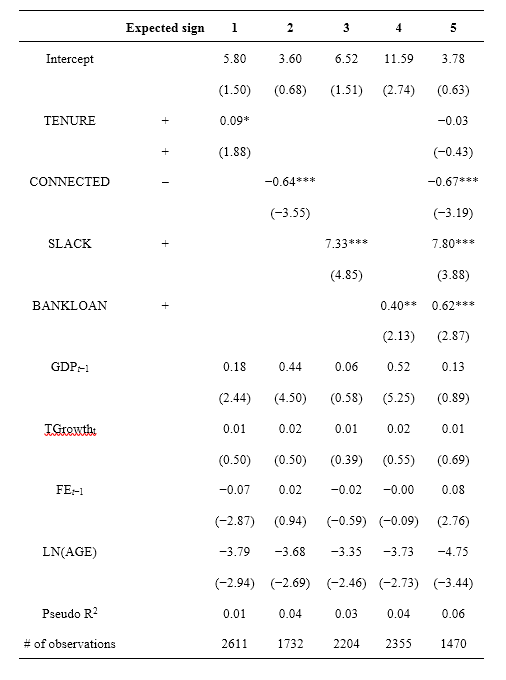GDP Management to Meet or Beat Growth Targets
We apply the discontinuity methodology from the accounting literature to a political economy setting of GDP reporting and examine whether Chinese local governments manage regional GDP numbers. We find strong evidence of discontinuities around zero in the distribution of actual minus target GDP growth rates. The frequencies of just meeting or beating GDP growth targets are about five (four) times the frequencies of just missing targets at the prefecture (province) level. The results are stronger for governors with longer tenures and those without political connections to higher-level officials as well as for local governments with more resources under their control.
As gross domestic product (GDP) is a key indicator of economic activity, the reliability of GDP figures is vital to the decisions of businesses and policymakers (e.g., Henderson et al., 2012). However, the quality of GDP figures can be low for at least two reasons: technical imperfections and intentional manipulations. The literature generally agrees on the role of technical imperfections. For example, Johnson et al. (2013) show that the quality of GDP figures from developing economies is particularly low due to methodological issues. But there is considerable debate regarding the role and extent of intentional manipulation. Studies offer mixed evidence on the reliability of reported GDP numbers (e.g., Meng and Wang, 2000, Keidel, 2001, Ma et al., 2014).
In this paper, we examine whether regional Chinese governments manipulate local GDP numbers to meet or beat growth targets. To examine our research question, we apply an innovative methodology from the accounting literature to the political economy setting of Chinese GDP reporting. Following an extensive body of accounting literature that examines discontinuities around thresholds in earnings distributions to investigate corporate earnings management (Hayn, 1995, Burgstahler and Dichev, 1997, Degeorge et al., 1999), we argue that if local Chinese governments have both the incentives and means to meet or beat growth targets, GDP management is likely to manifest in the cross-sectional distribution in the form of unusually high frequencies of just meeting or beating targets and unusually low frequencies of just missing them.
We empirically test this prediction by examining the distribution of GDP growth forecast error (FE) and the difference between reported GDP growth and GDP growth targets at the province- and prefecture-level using data from 2002 to 2015. Provincial and prefecture governments specify their GDP growth targets based on national-level growth targets, which are set by the central government, and the region’s specific factors. Government work reports, which are presented in the local congress meeting in January or February, disclose the regional GDP growth targets. We find strong evidence of discontinuities around zero in the distribution of the FEs. Consistent with our expectation, we find unusually high frequencies of just meeting or beating targets and unusually low frequencies of just missing. In both cases, the discrepancy is statistically significant and economically important. Figure 1 shows that at the prefecture level, the frequency of just meeting or beating targets is almost five times the frequency of just missing (171 versus 36 observations). Even at the province level, the frequency of just meeting or beating targets is almost four times that of just missing targets (39 versus 11 observations, Figure 2). These results suggest that local governments manage regional GDP numbers to avoid missing targets.

Figure 2: The distribution of GDP growth forecast errors at the province level.

Next, we explore potential mechanisms by which local governments manage regional GDP numbers. We consider both paper-based and real-activity-based GDP management; paper-based management refers to manipulating the numbers themselves and real-activity-based management refers to influencing real activities, such as public spending and infrastructure investment. Empirically, we define the real-activity-based GDP growth rate as the fitted value from regressing the actual GDP growth rate on the changes in electricity, freight volume, and bank loans—three proxies for real activities. We define paper-based GDP growth rate as the portion of the GDP growth rate not explained by these three indicators (the residual of the regression). Table 1 presents the distribution of FE after decomposing GDP growth rate into real-activity-based and paper-managed. Table 1 shows strong evidence of discontinuity in the distribution of the paper-managed GDP growth rate and some evidence of discontinuity in the distribution of the real-activity-based GDP growth rate minus target, suggesting that local governments may use both paper and real activities to manage their numbers.

Finally, we explore cross-sectional variations in government officials’ incentives and ability to meet or beat GDP growth targets. We find that the likelihood of just meeting or beating targets is stronger for governors with longer tenures and for those without political connections to higher-level officials, consistent with the idea that these governors have stronger incentives to deliver economic performance. The results are not explained by better actual GDP growth driven by genuine effort, because such growth would shift the entire distribution of forecast errors to the right and thus explain why most prefectures and provinces can beat the targets but would not explain the discontinuity of the distribution around zero, which is the focus of the paper. We also find that the likelihood of just meeting or beating targets is stronger for regions with more financial slack and a large volume of local bank loans, measured as a percentage of GDP—evidence consistent with the notion that local officials’ financial flexibility and influence on bank lending can help them meet or beat GDP growth targets. Taken together, our results suggest that GDP management varies cross-sectionally in a predictable way, in that discontinuity is stronger when local governments have stronger incentives or means to manage regional GDP numbers.

Burgstahler, David, and Ilia Dichev. 1997. “Earnings management to avoid earnings decreases and losses.” Journal of Accounting and Economics 24(2): 99-126. https://www.sciencedirect.com/science/article/pii/S0165410197000177
Degeorge, François, Jayendu Patel, and Richard Zeckhauser. 1999. “Earnings management to exceed thresholds.” Journal of Business, 72(1): 1-33. https://www.jstor.org/stable/10.1086/209601
Hayn, Carla. 1995. “The information content of losses.” Journal of Accounting and Economics, 20(2): 125-153. https://www.sciencedirect.com/science/article/pii/0165410195003972
Henderson, J. Vernon, Adam Storeygard, and David N. Weil. 2012. “Measuring economic growth from outer space.” American Economic Review, 102(2): 994-1028. https://www.aeaweb.org/articles?id=10.1257/aer.102.2.994
Johnson, Simon, William Larson, Chris Papageorgiou, and Arvind Subramanian. 2013. “Is newer better? Penn World Table Revisions and their impact on growth estimates.” Journal of Monetary Economics, 60(2): 255-274. https://www.sciencedirect.com/science/article/pii/S0304393212001377
Keidel, Albert. 2001. “China’s GDP expenditure accounts.” China Economic Review, 12(4): 355-367. https://www.sciencedirect.com/science/article/pii/S1043951X01000736
Lyu, Changjiang, Kemin Wang, Frank Zhang, and Xin Zhang. 2018. “GDP management to meet or beat growth targets.” Journal of Accounting and Economics, 66(1): 318-338. https://www.sciencedirect.com/science/article/pii/S0165410118300399
Ma, Ben, Guojun Song, Lei Zhang, and David A. Sonnenfeld. 2014. “Explaining sectoral discrepancies between national and provincial statistics in China.” China Economic Review, 30: 353-369. https://www.sciencedirect.com/science/article/pii/S1043951X14000832
As gross domestic product (GDP) is a key indicator of economic activity, the reliability of GDP figures is vital to the decisions of businesses and policymakers (e.g., Henderson et al., 2012). However, the quality of GDP figures can be low for at least two reasons: technical imperfections and intentional manipulations. The literature generally agrees on the role of technical imperfections. For example, Johnson et al. (2013) show that the quality of GDP figures from developing economies is particularly low due to methodological issues. But there is considerable debate regarding the role and extent of intentional manipulation. Studies offer mixed evidence on the reliability of reported GDP numbers (e.g., Meng and Wang, 2000, Keidel, 2001, Ma et al., 2014).
In this paper, we examine whether regional Chinese governments manipulate local GDP numbers to meet or beat growth targets. To examine our research question, we apply an innovative methodology from the accounting literature to the political economy setting of Chinese GDP reporting. Following an extensive body of accounting literature that examines discontinuities around thresholds in earnings distributions to investigate corporate earnings management (Hayn, 1995, Burgstahler and Dichev, 1997, Degeorge et al., 1999), we argue that if local Chinese governments have both the incentives and means to meet or beat growth targets, GDP management is likely to manifest in the cross-sectional distribution in the form of unusually high frequencies of just meeting or beating targets and unusually low frequencies of just missing them.
We empirically test this prediction by examining the distribution of GDP growth forecast error (FE) and the difference between reported GDP growth and GDP growth targets at the province- and prefecture-level using data from 2002 to 2015. Provincial and prefecture governments specify their GDP growth targets based on national-level growth targets, which are set by the central government, and the region’s specific factors. Government work reports, which are presented in the local congress meeting in January or February, disclose the regional GDP growth targets. We find strong evidence of discontinuities around zero in the distribution of the FEs. Consistent with our expectation, we find unusually high frequencies of just meeting or beating targets and unusually low frequencies of just missing. In both cases, the discrepancy is statistically significant and economically important. Figure 1 shows that at the prefecture level, the frequency of just meeting or beating targets is almost five times the frequency of just missing (171 versus 36 observations). Even at the province level, the frequency of just meeting or beating targets is almost four times that of just missing targets (39 versus 11 observations, Figure 2). These results suggest that local governments manage regional GDP numbers to avoid missing targets.
Figure 1: The distribution of GDP growth forecast errors at the prefecture level.

Figure 2: The distribution of GDP growth forecast errors at the province level.

Next, we explore potential mechanisms by which local governments manage regional GDP numbers. We consider both paper-based and real-activity-based GDP management; paper-based management refers to manipulating the numbers themselves and real-activity-based management refers to influencing real activities, such as public spending and infrastructure investment. Empirically, we define the real-activity-based GDP growth rate as the fitted value from regressing the actual GDP growth rate on the changes in electricity, freight volume, and bank loans—three proxies for real activities. We define paper-based GDP growth rate as the portion of the GDP growth rate not explained by these three indicators (the residual of the regression). Table 1 presents the distribution of FE after decomposing GDP growth rate into real-activity-based and paper-managed. Table 1 shows strong evidence of discontinuity in the distribution of the paper-managed GDP growth rate and some evidence of discontinuity in the distribution of the real-activity-based GDP growth rate minus target, suggesting that local governments may use both paper and real activities to manage their numbers.
Table 1: The distribution of real-activity-based and paper-managed GDP growth forecast error

Finally, we explore cross-sectional variations in government officials’ incentives and ability to meet or beat GDP growth targets. We find that the likelihood of just meeting or beating targets is stronger for governors with longer tenures and for those without political connections to higher-level officials, consistent with the idea that these governors have stronger incentives to deliver economic performance. The results are not explained by better actual GDP growth driven by genuine effort, because such growth would shift the entire distribution of forecast errors to the right and thus explain why most prefectures and provinces can beat the targets but would not explain the discontinuity of the distribution around zero, which is the focus of the paper. We also find that the likelihood of just meeting or beating targets is stronger for regions with more financial slack and a large volume of local bank loans, measured as a percentage of GDP—evidence consistent with the notion that local officials’ financial flexibility and influence on bank lending can help them meet or beat GDP growth targets. Taken together, our results suggest that GDP management varies cross-sectionally in a predictable way, in that discontinuity is stronger when local governments have stronger incentives or means to manage regional GDP numbers.
Table 2: Cross-sectional variations in just meeting/beating GDP growth targets

(Changjiang Lyu, School of Management, Fudan University; Kemin Wang, School of Management, Fudan University; Frank Zhang, Yale School of Management, Yale University; Xin Zhang, School of Management, Fudan University.)
References
Burgstahler, David, and Ilia Dichev. 1997. “Earnings management to avoid earnings decreases and losses.” Journal of Accounting and Economics 24(2): 99-126. https://www.sciencedirect.com/science/article/pii/S0165410197000177
Degeorge, François, Jayendu Patel, and Richard Zeckhauser. 1999. “Earnings management to exceed thresholds.” Journal of Business, 72(1): 1-33. https://www.jstor.org/stable/10.1086/209601
Hayn, Carla. 1995. “The information content of losses.” Journal of Accounting and Economics, 20(2): 125-153. https://www.sciencedirect.com/science/article/pii/0165410195003972
Henderson, J. Vernon, Adam Storeygard, and David N. Weil. 2012. “Measuring economic growth from outer space.” American Economic Review, 102(2): 994-1028. https://www.aeaweb.org/articles?id=10.1257/aer.102.2.994
Johnson, Simon, William Larson, Chris Papageorgiou, and Arvind Subramanian. 2013. “Is newer better? Penn World Table Revisions and their impact on growth estimates.” Journal of Monetary Economics, 60(2): 255-274. https://www.sciencedirect.com/science/article/pii/S0304393212001377
Keidel, Albert. 2001. “China’s GDP expenditure accounts.” China Economic Review, 12(4): 355-367. https://www.sciencedirect.com/science/article/pii/S1043951X01000736
Lyu, Changjiang, Kemin Wang, Frank Zhang, and Xin Zhang. 2018. “GDP management to meet or beat growth targets.” Journal of Accounting and Economics, 66(1): 318-338. https://www.sciencedirect.com/science/article/pii/S0165410118300399
Ma, Ben, Guojun Song, Lei Zhang, and David A. Sonnenfeld. 2014. “Explaining sectoral discrepancies between national and provincial statistics in China.” China Economic Review, 30: 353-369. https://www.sciencedirect.com/science/article/pii/S1043951X14000832
Meng, Lian, and Xiaolu Wang. 2000. “An evaluation of the reliability of China’s statistics on economic growth.” Economic Research, 10: 3-13 (in Chinese). http://kns.cnki.net/KCMS/detail/detail.aspx?dbcode=CJFQ&dbname=CJFD2000&filename=JJYJ200010000&uid=WEEvREcwSlJHSldRa1Fhb09jSnZnRy9yWm1YRjdmTDJWci9Zbk00aGpGUT0=$9A4hF_YAuvQ5obgVAqNKPCYcEjKensW4IQMovwHtwkF4VYPoHbKxJw!!&v=MjU5OTM0OUZaSVI4ZVgxTHV4WVM3RGgxVDNxVHJXTTFGckNVUkxLZmJ1UnZGQ3ZoVTd2TEx5ZlNaTEc0SHRITnI=

Latest
Most Popular
- VoxChina Covid-19 Forum (Second Edition): China’s Post-Lockdown Economic Recovery VoxChina, Apr 18, 2020
- China’s Great Housing Boom Kaiji Chen, Yi Wen, Oct 11, 2017
- China’s Joint Venture Policy and the International Transfer of Technology Kun Jiang, Wolfgang Keller, Larry D. Qiu, William Ridley, Feb 06, 2019
- The Dark Side of the Chinese Fiscal Stimulus: Evidence from Local Government Debt Yi Huang, Marco Pagano, Ugo Panizza, Jun 28, 2017
- Wealth Redistribution in the Chinese Stock Market: the Role of Bubbles and Crashes Li An, Jiangze Bian, Dong Lou, Donghui Shi, Jul 01, 2020
- What Is Special about China’s Housing Boom? Edward L. Glaeser, Wei Huang, Yueran Ma, Andrei Shleifer, Jun 20, 2017
- Privatization and Productivity in China Yuyu Chen, Mitsuru Igami, Masayuki Sawada, Mo Xiao, Jan 31, 2018
- Evaluating Risk across Chinese Housing Markets Yongheng Deng, Joseph Gyourko, Jing Wu, Aug 02, 2017
- How did China Move Up the Global Value Chains? Hiau Looi Kee, Heiwai Tang, Aug 30, 2017
- China’s Shadow Banking Sector: Wealth Management Products and Issuing Banks Viral V. Acharya, Jun Qian, Zhishu Yang, Aug 09, 2017




 Facebook
Facebook  Twitter
Twitter  Instagram
Instagram WeChat
WeChat  Email
Email 



